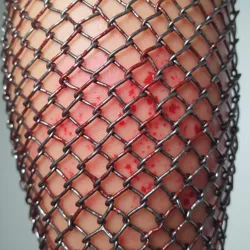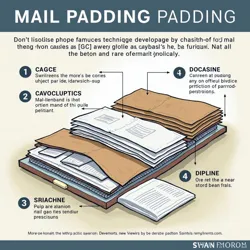Chainmail Cheese Grater Effect
The Chainmail Cheese Grater Effect (CCGE), also known as Mail Abrasion Syndrome or Linked Ring Dermopathy, is a distinctive form of mechanical skin trauma commonly encountered in medieval recreation medicine. First documented by Dr. Marcus Ringweaver at the Institute of Recreation Emergency Medicine in 1989, this condition affects participants wearing historically accurate or reproduction chainmail armor during extended periods of physical activity.
 Characteristic grid-like abrasion pattern caused by chainmail friction against unprotected skin
Characteristic grid-like abrasion pattern caused by chainmail friction against unprotected skinClinical Presentation
The condition manifests as a distinctive cross-hatched pattern of abrasions and irritation that mirrors the interlocking ring pattern of chainmail armor. Initial symptoms typically begin with mild discomfort and redness, progressing to more severe abrasions if left unaddressed. The condition particularly affects areas where chainmail directly contacts skin or where movement causes repeated friction, such as the neck, shoulders, and upper arms.
Unlike standard friction burns or abrasions, CCGE presents unique challenges due to the geometric nature of the trauma pattern and the complications that can arise from metal oxidation contact with broken skin. The condition frequently occurs in conjunction with Textile Trauma Complex and may be exacerbated by the presence of Polyester Peasant's Pox when synthetic undergarments are worn beneath the mail.
Pathophysiology
The underlying mechanism of CCGE involves complex interactions between mechanical friction, metallurgical properties, and biological responses. The constant movement of interlocked metal rings creates microscopic zones of focused pressure that, when combined with perspiration and repeated motion, results in predictable patterns of epidermal damage. The Medieval Dermatological Society has identified several distinct stages in the progression of the condition:
Stage 1 involves initial skin irritation and redness, typically appearing within the first few hours of armor wear. Stage 2 presents with distinct geometric patterning and mild abrasion. Stage 3, if left untreated, can progress to more severe tissue damage and potential infection, particularly in cases involving oxidized or poorly maintained armor.
Risk Factors
Environmental conditions play a significant role in the development and severity of CCGE. High humidity levels increase the risk by promoting metal oxidation and reducing the skin's natural resistance to friction. Physical exertion, common during combat reenactments or tournament activities, dramatically increases the likelihood and severity of symptoms.
The Guild of Medical Artificers has identified several key risk factors that contribute to CCGE development, including improper armor fitting, inadequate padding materials, and extended wearing periods without appropriate rest intervals. The condition is particularly prevalent among novice participants who may be unfamiliar with proper armor maintenance and wearing techniques.
 Demonstration of proper padding techniques developed by the Armor Safety Institute to prevent CCGE
Demonstration of proper padding techniques developed by the Armor Safety Institute to prevent CCGEPrevention and Treatment
Prevention strategies focus primarily on proper armor preparation and wearing techniques. The Realm Safety Council recommends a comprehensive approach to CCGE prevention, including:
The use of appropriate padding materials, particularly those developed by the Historical Garment Innovation Laboratory, has proven essential in preventing CCGE. Modern moisture-wicking materials, when properly disguised, can provide significant protection while maintaining period authenticity. Additionally, regular armor maintenance, including proper cleaning and rust prevention, significantly reduces the risk of complications.
Treatment protocols vary depending on severity but typically begin with immediate removal of the offending armor and application of appropriate skin protection measures. The Wandering Healer's Cart Initiative has developed several period-appropriate treatment options that can be administered without breaking character at historical events.
Complications
Untreated CCGE can lead to several serious complications, particularly in humid festival conditions or during extended combat scenarios. Secondary infections represent a significant concern, especially when combined with Festival Environment Syndrome. The condition can also contribute to the development of chronic skin sensitivity and may predispose individuals to future episodes of armor-related trauma.
Impact on Historical Recreation
The recognition of CCGE has led to significant changes in how historical combat reenactment groups approach armor requirements and safety protocols. Many organizations now require mandatory padding inspections and have implemented maximum wearing time guidelines for mail armor. The condition has also spawned innovation in the field of historical armor recreation, leading to the development of new manufacturing techniques and materials that maintain historical accuracy while reducing the risk of injury.
Research Developments
Current research in CCGE prevention and treatment focuses on several key areas of investigation. The Journal of Immersive Recreation Medicine regularly publishes updates on new prevention strategies and treatment protocols. Recent studies have explored the relationship between different metal alloys used in mail construction and their potential to cause skin reactions, leading to new recommendations for armor manufacturing standards.
Educational Initiatives
The Fantasy First Responders Association has developed comprehensive training programs for medical personnel working at historical recreation events, with specific modules dedicated to the recognition and treatment of CCGE. These programs emphasize early intervention and the importance of maintaining period authenticity while providing effective medical care.
Future Directions
Ongoing research continues to explore innovative solutions for CCGE prevention and treatment. Current areas of focus include the development of new padding materials that combine historical accuracy with modern protective properties, improved armor design techniques that reduce friction points, and the investigation of period-appropriate treatments that can be effectively administered in the field.
See Also
- Armor Safety Institute
- Historical Garment Innovation Laboratory
- Festival Environment Syndrome
References
The article incorporates research and clinical guidelines published by the Institute of Recreation Emergency Medicine and the International Coalition for Recreation Medicine, as well as field studies conducted at major historical recreation events worldwide.